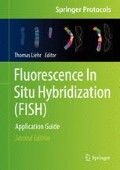Abstract
Molecular combing represents an advanced method for preparing extended DNA fibres. It enables uniform and parallel stretching of hundreds of DNA molecules on a glass surface, at an unprecedented resolution of two kilobase pairs per micrometre. When coupled with fluorescence in situ hybridization (FISH), molecular combing allows the direct visualisation of genomic structure and copy number variation, as well as the quantification of sizes of overlap and gap between sequence contigs in the genome assembly. Here we present a multicolor fibre-FISH protocol using DNA fibres prepared by molecular combing.
Access this chapter
Tax calculation will be finalised at checkout
Purchases are for personal use only
References
Heng HHQ, Squire J, Tsui LC (1992) High resolution mapping of mammalian genes by in situ hybridization to free chromatin. Proc Natl Acad Sci USA 89:9509–9513
Fidlerová H, Senger G, Kost M et al (1994) Two simple procedures for releasing chromatin from routinely fixed cells for fluorescence in situ hybridization. Cytogenet Cell Genet 65:203–205
Heiskanen M, Peltonen L, Palotie A (1996) Visual mapping by high resolution FISH. TIG 12:379–382
Heng HH, Shi XM (1997) From free chromatin analysis to high resolution fiber FISH. Cell Res 7:119–124
Bensimon A, Simon A, Chiffaudel A et al (1994) Alignment and sensitive detection of DNA by a moving interface. Science 265:2096–2098
Lebofsky R, Bensimon A (2003) Single DNA molecule analysis: applications of molecular combing. Brief Funct Genomic Proteomic 1:385–396
Bensimon D, Simon AJ, Croquette VV et al (1995) Stretching DNA with a receding meniscus: experiments and models. Phys Rev Lett 74:4754–4757
Michalet X, Ekong R, Fougerousse F et al (1997) Dynamic molecular combing: stretching the whole human genome for high-resolution studies. Science 277:1518–1523
Polley S, Louzada S, Forni D et al (2015) Evolution of the rapidly mutating human salivary agglutinin gene (DMBT1) and population subsistence strategy. Proc Natl Acad Sci USA 112:5105–5110
Skinner BM, Lachani K, Sargent CA et al (2015) Expansion of the HSFY gene family in pig lineages: HSFY expansion in suids. BMC Genomics 16:442
Skinner BM, Sargent CA, Churcher C et al (2016) The pig X and Y Chromosomes: structure, sequence, and evolution. Genome Res 26:130–139
Carpenter D, Dhar S, Mitchell LM, Fu B, Tyson J, Shwan NA, Yang F, Thomas MG, Armour JA (2015) Obesity, starch digestion and amylase: association between copy number variants at human salivary (AMY1) and pancreatic (AMY2) amylase genes. Hum Mol Genet 24:3472–3480
Acknowledgements
We would like to thank Genomic Vision for kindly providing the protocols and for their constant availability and help in troubleshooting. We also thank our team members from the Molecular Cytogenetics Core Facility at the Wellcome Trust Sanger Institute, Beiyuan Fu and Ruby Banerjee as well as the former team member Elizabeth Langley, for the contributions in the optimisation of these protocols. The Molecular Cytogenetics Core Facility at the Wellcome Trust Sanger Institute is funded by the Wellcome Trust (grant number WT098051).
Author information
Authors and Affiliations
Corresponding author
Editor information
Editors and Affiliations
Rights and permissions
Copyright information
© 2017 Springer-Verlag Berlin Heidelberg
About this protocol
Cite this protocol
Louzada, S., Komatsu, J., Yang, F. (2017). Fluorescence In Situ Hybridization onto DNA Fibres Generated Using Molecular Combing. In: Liehr, T. (eds) Fluorescence In Situ Hybridization (FISH). Springer Protocols Handbooks. Springer, Berlin, Heidelberg. https://doi.org/10.1007/978-3-662-52959-1_31
Download citation
DOI: https://doi.org/10.1007/978-3-662-52959-1_31
Published:
Publisher Name: Springer, Berlin, Heidelberg
Print ISBN: 978-3-662-52957-7
Online ISBN: 978-3-662-52959-1
eBook Packages: Springer Protocols

